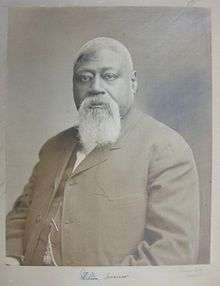James Milton Turner
| James Milton Turner | |
|---|---|
 | |
| Assistant superintendent of Missouri schools | |
|
In office After Civil War – pre-1871 | |
| American ambassador to Liberia | |
|
In office 1871–1878 | |
| Personal details | |
| Born |
1840 St. Louis, Missouri |
| Died |
Nov 1, 1915 (75 years old)[1] Ardmore, Oklahoma |
| Nationality | American |
| Political party | Radical Republicans |
| Alma mater |
Oberlin College John Berry Meachum's floating Freedom School |
James Milton Turner (1840-1915) was a post Civil War political leader, activist, educator, and diplomat. As ambassador to Liberia, he was the first African-American to serve in the U.S. diplomatic corps.
Early life
Turner was born into slavery in St. Louis, Missouri. When he was a child he was sold on the steps of the St Louis courthouse for $50 (US$ 1,400 in 2016).[1] His father, John Turner, was a "horse doctor" who was eventually able to purchase freedom for himself and his family. At fourteen, James Turner attended Oberlin College in Ohio for one term until he had to return to St. Louis to care for his family following his father's death in 1855. There, Turner attended John Berry Meachum's floating Freedom School on a steamboat on the Mississippi River, which Meachum had set up to evade the Missouri law against education for blacks that was passed in 1854.
Career
When the American civil war broke out, Turner enlisted in the Union Army and served as body servant for Col. Madison Miller. A wound he received during the war left him with a permanent limp. After the war, Miller's brother-in-law, Missouri Governor Thomas Fletcher, appointed him assistant superintendent of schools. As such, he was responsible for setting up schools for black Missourians. He helped establish the Lincoln Institute in Jefferson City, the first institution of higher education for African-Americans in Missouri. The Institute's name was later changed to Lincoln University. As a politician, Turner, an outspoken member of the Radical Republicans and a leader of the Missouri Equal Rights League, was held in high regard for his oratorical skills.[2] In 1868 he was installed as the principal of Lincoln School the first school for blacks in Kansas City, Missouri. In this position he was succeeded by J. Dallas Bowser.[3]
In 1871, he was appointed ambassador to Liberia by President Ullyses S.Grant. He relocated to Monrovia and held that post until 1878. When he returned to St. Louis, he played an important role in helping to resettle black refugees from the ex-confederate states in the South and in organizing blacks as a political force. He took part in the relief efforts for African-Americans who had left the South for Kansas as part of the Exoduster Movement of 1879., many of whom ended up in St. Louis. In 1881, he was responsible, with Hannibal Carter,for organizing the Freedmen’s Oklahoma Immigration Association to promote black homesteading in Oklahoma. As chairman of the Negro National Republican Committee, he proposed nominating another African-American, senator Blanche Bruce , as the vice presidential candidate on the Republican ticket in 1880.[4]
Turner spent the last two decades of his life devoted himself to fighting for the rights of Cherokee, Choctaw, and Chickasaw freedmen in the Indian Territory.[5] He successfully lobbied Congress for the nearly 4,000 freed slaves of the Cherokee to receive $75,000 (US$ 1,978,600 in 2016) from funds that the US. government paid the tribe for their land. In Ardmore, Oklahoma, while he was representing the freedmen in a legal dispute, a nearby railroad car exploded and the debris from it cut his left hand.
Turner died from blood poisoning from the explosion in 1915 in Ardmore, Oklahoma.[6][7][8][9]
Bibliography
Notes
- 1 2 Tulsa daily world 1915, p. 1
- ↑ Jack 2007
- ↑ Coulter, Charles Edward. Take Up the Black Man's Burden: Kansas City's African American Communities, 1865-1939. University of Missouri Press, 2006. p23
- ↑ Gilder Lehrman Institute of American History 1880
- ↑ Hine & Jenkins 2001, p. 71
- ↑ Dillard 1934, pp. 372–411
- ↑ Turner & Dilliard 1941, pp. 1–11
- ↑ Kremer 1991
- ↑ Appel 2010
References
- Appel, Phyllis (2010). The Missouri Connection: Profiles of the Famous and Infamous. Graystone Enterprises LLC. ISBN 9780984538102. - Total pages: 216
- Jack, Bryan M. (2007). The St. Louis African American Community and the Exodusters. University of Missouri Press. ISBN 9780826266163. - Total pages: 178
- Dillard, Irving (October 1934). "James Milton Turner, A Little Known Benefactor of His People.". The Journal of Negro History. 19 (4): 372–411. ISSN 1548-1867. JSTOR i347364.
- Gilder Lehrman Institute of American History (1880). "Nominating an African-American for President". Gilder Lehrman Institute of American History. Retrieved November 2, 2015.
- Hine, Darlene Clark; Jenkins, Earnestine (2001). A Question of Manhood: A Reader in U.S. Black Men's History and Masculinity, Volume 2. Indiana University Press. ISBN 9780253214607. - Total pages: 482
- Kremer, Gary R. (1991). James Milton Turner and the Promise of America: The Public Life of a Post-Civil War Black Leader. University of Missouri Press. ISBN 9780826207807. - Total pages: 245
- Tulsa daily world (November 2, 1915). "Sold as slave ardmore fire is fatal to him". Tulsa daily world. Tulsa, Oklahoma. ISSN 2330-7234. OCLC 4450824. Archived from the original on November 2, 2015. Retrieved November 2, 2015.
- Turner, J. Milton; Dilliard, Irving (January 1941). "Dred Scott Eulogized by James Milton Turner: A Historical Observance of the Turner Centenary: 1840-1940". The Journal of Negro History. 26 (1): 1–11. ISSN 1548-1867. JSTOR 2715047.
Further reading
- Walton, Hanes; Rosser, James Bernard; Stevenson, Robert L. (2002). Liberian Politics: The Portrait by African American Diplomat J. Milton Turner. Lexington Books. ISBN 9780739103449. - Total pages: 417